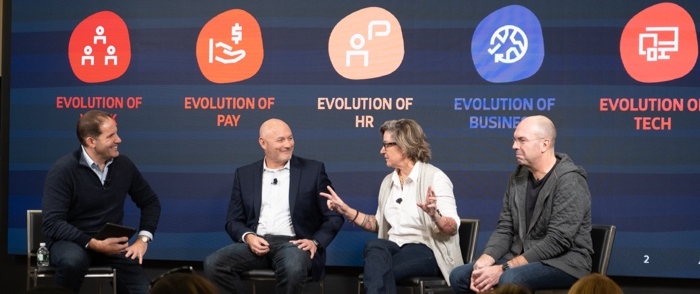The future of work you’ve been waiting for is already here. The most successful companies have moved to agile, team-based structures, unleashing the power of their talent and improving engagement and productivity. How can companies and their people thrive in today’s rapidly changing business environment?
Change is the name of the game in the evolving workforce. The emergence of dynamic teams, the reliance on gig workers and shifts in the technology needed to get work done are just a few of the variables pushing businesses of all sizes to reimagine the way they work and support their people.
Don Weinstein, ADP Corporate Vice President and Head of Global Product and Technology, led a panel during the 2019 Fast Company Innovation Festival held at ADP’s Chelsea Innovation Labs in New York City.
“What a great time to be talking about innovation in the world of work. I’ve been around the industry for a while now, and I have never seen the pace of change that we’re experiencing right now,” said Weinstein.
Weinstein, joined by ADP executives Doug Politi, President of Compliance Solutions; Roberto Masiero, Senior Vice President of ADP Innovation Labs; and Martha Bird, Chief Anthropologist, discussed the factors reshaping the world of work. And workers themselves are a significant force behind the evolution.
“I think employee expectations of technology and the immediacy of money itself is so drastically different than just five years ago,” said Politi.
Politi pointed to millennials as leaders in this trend. “I have three millennial kids, and they rarely, if ever, go to a bank,” he shared. “They are totally removed from traditional banking institutions. Their phones have become their banks and their cash.”
“All these things affect the way they want to get paid. They have expectations of pay flexibility — as such, we are shifting away from brick and mortar banking institutions to very flexible, open, mobile-based tools,” Politi said.
Research shows that people are actually more likely to consider employers who offer multiple pay options, another trend forcing employers to integrate new technology, such as flexible pay applications, into their human capital management systems.
“This new world of work that we’re living in — it’s dynamic, it’s messy and it’s much harder. But I think it’s interesting, and it gives us more opportunity to innovate.“
Don Weinstein, Corporate Vice President and Head of Global Product and Technology at ADP
For every business, compliance is critical. Politi noted that in regard to how ADP is rethinking its payment capabilities, working with the government on the federal and local level, as well as advocacy groups, is like “threading that needle.”
Masiero said his team at the ADP Innovation Labs uses the term cultural precision to describe cultural perception of things like money, technology and time. Cultural precision is invaluable when innovating for large numbers of end users, “especially as we move closer to the consumer,” he said. “Instead of looking at one company, we think in terms of millions of people.”
Another theme that emerged from the conversation was how innovation needs space and time to thrive, often free from the day-to to-day constraints that impact other teams. But just how freewheeling and unstructured can the creative process be?
According to Masiero, “There’s no formula to creating innovation. Companies need to establish innovation as a discipline within the organization, whether through a grassroots movement, or a campaign, or a dedicated department, to focus on innovation.” It’s also important to make sure this team is separated from the daily routine of client work.
Time, space, and the freedom to work and innovate are all important environmental factors for innovation in the workplace of the future. But equally important for business leaders is to make sure they’re assembling the right people.
“Putting together people from diverse geographies, ethnicities, socioeconomic backgrounds, disciplines and the like can create helpful friction,” said Bird. Friction in this sense is a positive outcome of a team coming at challenges with a multiplicity of perspectives in an inclusive work environment. But it’s equally important that everyone is humble and curious — key attributes for diverse teams tasked with innovation.
Strong leadership and a clear vision are considered more important than maintaining a rigid hierarchy. “To accomplish something big, you have to collaborate with others. You all need to work together for a higher vision. You’ve got to grab people and subject matter experts from here and there, unifying to achieve that vision,” Masiero said. “Companies care less about the structure of the hierarchy. It’s important they have leaders, not bosses.”
Weinstein closed by pointing to the upside of the dramatic shifts in the labor market.
“This new world of work that we’re living in — it’s dynamic, it’s messy and it’s much harder,” he said. “But I think it’s interesting, and it gives us more opportunity to innovate.”



